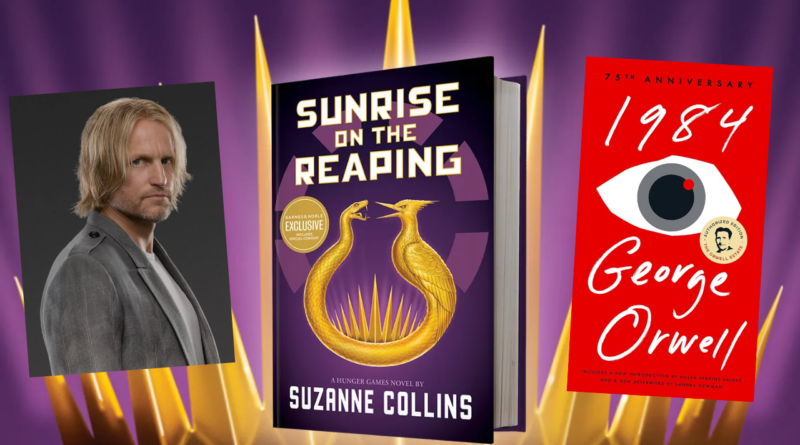Sunrise on the Reaping: The 1984 of 2025
Suzanne Collins received inspiration for The Hunger Games, a trilogy of dystopian YA novels, when watching her TV one night. Flipping between channels covering the Iraq war and those playing episodes of reality TV, including Survivor (2000), led to the creation of the terrifying world of Panem. Amongst the series, Collins makes plentiful references to other classic dystopian novels including George Orewell’s 1984 (1949). Many of the underlying themes in both novels serve as critiques of the current political climate.
The original novels in The Hunger Games trilogy were released from 2008 to 2010, with movie adaptations following shortly in 2012. Suzanne Collins shocked the world when she released a fourth book in the series, The Ballad of Songbirds and Snakes, in 2020. This prequel focused on the soon to be President Snow’s rise to power and Lucy Gray Baird’s survival of the 10th Hunger Games.
To the surprise of some, another prequel book has been released. Sunrise on the Reaping was released on March 18th this year, and follows a 16-year old Haymitch Abernathy (Katniss and Peeta’s mentor in the original trilogy) and his survival in the 50th Hunger Games. This Quarter Quell required each district to send double the amount of tributes. Some of his story is already mentioned in the original trilogy, such as Haymitch’s arena being filled with beautiful yet deadly ecology. We also learn he won by “using the arena” – letting his final opponent’s axe hit the force field boundary and reflect back onto her, leaving him the sole survivor after playing a solo strategy the entire game.

Haymitch Abernathy, portrayed by Woody Harrelson in 2012.
Spoilers below, read at your own risk!
What we learn in Sunrise on the Reaping is just how much of the games are reliant on manipulation of Capitol citizens and clever editing techniques. We also find out that Haymitch’s birthday falls on the same day as Reaping day, which just so happens to be the 4th of July. The book provides much needed context for the rest of the series and is an interesting new perspective of the games. Genuine teamwork is a new aspect of the games, and interestingly, the strongest career tributes, tributes trained their whole lives for the Games, are seen as unfavorable for the first time. This also features the most interesting arena, since most survival skills (foraging for food and water) are rendered useless with the poisonous environment.
Before Haymitch’s time in the arena, we meet familiar faces such as Wiress and Mags who mentor him, and Beetee who is forced to mentor his own son in the games as punishment. Effie Trinket also appeared in lieu of District 12’s originally assigned toad-licking stylist. Many have been of the opinion that these are merely cameo interactions to appeal to fans, however they create meaningful context that puts Catching Fire (2009) in an entirely new light. Their reasons for being in the story, all of whom are being punished in some way, are very much justified, and add layers of depth to create a richer narrative. There are also call-forwards to the 2025 prequel that were made all the way back in 2012, enough of them to make me believe Collins had most of the series planned much earlier than we think. One example of this includes a line from Sunrise on the Reaping’s first page being featured on one version of the Catching Fire (2013) movie poster: “The sun persists in rising, so I make myself stand.” The importance of these novels as social commentary far outweighs the possibility of Collins wanting a quick cash grab with character cameos.
Just like her characters, Suzanne Collins only sings when she has something to say. This book was a beautiful mix of George Orwell’s 1984 and social commentary on the current United States of America. The book itself opens on the 1984 quote “All propaganda is lies, even when one is telling the truth. I don’t think this matters so long as one knows what one is doing, and why,” which is applied throughout this prequel as propaganda is the main tactic used against Panem’s citizens. Not only in the banners glorifying all that the Capitol provides, but also in the way history is constantly being edited, live events misconstrued, and reapings rigged. Suzanne makes these themes of propaganda extremely evident along with many other references to Big Brother watching, including Haymitch’s TV being uncontrollable and playing traumatizing footage as he is surrounded by hundreds of cameras. In Orwell’s 1984, televisions play propaganda 24/7 and are unable to be turned off. Cameras are also planted in practically every room in Orwell’s novel.

A featured propaganda poster from Orwell’s 1984 warning citizens to be on their best behavior.
The fifth installment of the series creates a nauseating pattern of district 12 tributes rarely, if ever, having a fair reaping day (if one could even exist). Lucy Gray in the 10th games has an enemy rig the reaping, Katniss was ‘compelled’ to volunteer in the 74th games, and Haymitch was simply in the wrong place at the wrong time. None of them were ever truly supposed to end up in the arena. This is hauntingly similar to 1984 when random people would simply be at the wrong place at the wrong time, or commit an act known as thoughtcrime, and end up erased from history forever. Essentially, both novels warn about times when people are taken away to be punished and even killed for even thinking against those in power. Since Haymitch is the only tribute seen to go onto mentorship and “live the life of a victor,” this is the first opportunity to truly recognize how the Capitol treats victors (which is not very well at all, and almost always includes torture).
Throughout the prequel, you realize as the reader, you yourself have been a victim of Capitol propaganda. In Catching Fire, it is told that Haymitch won his games by staying by himself most of the time in the arena. The new prequel reveals that this wasn’t true at all, and was just a technique to cover any of his rebellious behaviors. Sunrise on the Reaping contains an extremely prevalent theme on the disruption of harmony. Any form of relationship Haymitch may have is completely destroyed; any sense of peace he felt before his 16th birthday now lay in bottles of liquor. He and many, many, other characters are punished for banding together with other tributes, victors, or fellow citizens. The President knows a few small teams are much less efficient than one combined power, to continue to pit the poor against the poor so no one has a second to look up and see who actually controls every aspect of their lives. By simply editing the footage, any signs of a coordinated effort against the Capitol have been destroyed. No one in Panem can be allowed to feel a state of unity or community. This is a reflection of the explicit oppression of any relationships seen throughout George Orwell’s dystopia, where love and friendships are seen as shameful behaviors and generally discouraged. Throughout Sunrise on the Reaping, we learn just how connected the tributes all are despite their oppression, and remnants of a shared culture begin to emerge. Empathy and friendship are possible, but dangerous ideas to behold.
Collins’ message rings loud and clear: If you let them, they will change the past and rewrite history right in front of your eyes.
Despite its dystopian dread, Sunrise on the Reaping was an incredible story of love persisting. Whether in the form of grief-riddled nightmares or a family of geese. Haymitch survives his games because he had the capability to see a sister in his enemy, his best friend’s face in a young girl who volunteered, and love them despite what he was told they are. The novel also expands the Hunger Games universe and fills in many of the gaps left between the 10th and 74th games. I am also very excited to see the movie adaptation, though I’m left wondering how they can possibly make this one PG-13.

